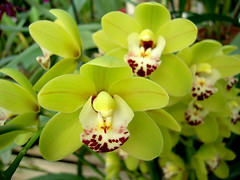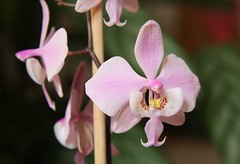Green Cymbidium Orchids
Green Cymbidum Orchids come in many pleasing shades of green. They can range from light green to dark green and they can have red, green, white, pink or yellow centers. They are awesome because despite being green they always look like a flower and are not likely to be mistaken for leaves. Whether you are looking for a cut flower or for a great orchid plant, these orchids are ideal specimens for you.
Wedding Flowers
These orchids make great flowers for proms or for weddings. They make exceptional and long lasting bouquets and are also perfect for boutonnieres. The great thing about them is that they can last a very long time as a cut flower. With the proper care they can last several weeks, so you can order them a few days early if you have a special occasion coming up.
These flowers will be shipped to you in a box, while still attached to their stems. Online retailers will ship them with water tubes on the end of their stems to keep them from drying out. When you get them, you need to unpack them and remove their water tubes. Next you need to trim a quarter of an inch from the end of their stems to open up their pores and then you need to place them in a vase filled with clean water. Store them in a cool room at about 65 degrees and keep the room as dark as possible until your big event.
Cymbidum Facts
Stems of these flowers can be up to twenty-three inches long and you will usually find eight to twelve flowers on each stem. And some cymbidiums can have scents that smell like sandalwood or even citrus. They are also known as “boat orchids”, unfortunately I have no idea how they got this name.
Green cymbidium orchids usually bloom during the winter, but of course if you can manipulate their growing environment you can get them to bloom whenever you want them to bloom. If left on the plant, their flowers can last up to ten weeks. So if you have a green thumb you might want to consider growing them, rather than buying them as a cut flower to put into a vase. These orchids used to be very popular in victorian era Europe, because they were able to tolerate cold european winters better than many other species of orchid. They can survive temperatures as low as forty-five degrees, but I wouldn’t push things too far if I were you.
Rare Orchids
Are you interested in buying rare orchids?
One of the top orchid breeders in Hawaii is located about 9 miles away from our farm. He has been developing exotic new varieties of orchids for a number of decades and he has quite a few varieties which are either one of a kind (since they are completely new hybrids that he created) or one of less than a hundred (in the whole world).
I’m thinking of adding a few of these incredibly rare orchids to our catalog, but only if there is interest. I would expect prices to range from $75 to $150 per plant.
So are you interested in orchids that you can’t find anywhere else? If you are, please use our contact form to reach me.
Amazon Bestsellers: Green Orchids
Phalaenopsis Orchid Care
Don’t be tricked by the exotic beauty of Phalaenopsis, they don’t require extraordinary care. Just follow these basic Phalaenopsis Orchid Care guidelines and your plant will bloom for years to come.
Vital Phalaenopsis Watering Tips
Watering your Phalaenopsis is very important. Like all plants, if you forget to water it, it will die. Moreover, these orchids lack a bulb to store moisture, so they are even more prone to dying if you forget to water them. Over watering these plants can also be very harmful. Too much water can cause fungal or bacterial rotting. Use pure water to water them, if you wouldn’t drink it, you probably shouldn’t give it to your plant. If you live in a region with hard water, never give your plant water that has been treated with water softening agents. Aim to use distilled water or water that has been purified by reverse osmosis.
It’s best to water your plant in the morning, so that it has all day to dry out by the evening. Leaving water on your plant or letting your plant sit in a drip tray that is full of water is a bad idea. If you don’t get rid of excess water and especially if you let the roots of your plant sit in water it will eventually die.
In general, your plant should be watered every four to seven days, but you should always keep an eye on the moisture levels of the potting soil. You never want it to become bone dry as this will shock the roots of your plant. But you definitely do not want it to be oversaturated with water either. Essentially, you should water again once the soil gets somewhat dry, but before it gets bone dry.
Correct Light Levels
The Phalaenopsis doesn’t require direct sunlight. In fact, direct sunlight can harm them. If you must place them by a window that gets direct sunlight, try placing a sheer curtain between the window and your plant to filter out a little light. Or just place your plant near a window that gets indirect sunlight. During the winter when light levels are lower, you might want to consider moving your plant to an area that gets a little more light.
Acceptable Temperature Ranges
These types of orchids don’t like to get too cold. If you let them freeze, they will die. The ideal night time temperature for these plants is 62 degrees or higher, and the ideal day time temperature is between 70 and 80 degrees. Thus, these orchids make excellent house plants as these are likely the temperatures that you can find within your home.
Proper Humidity Levels
These plants lack a bulb to store water, so they prefer high humidity. The ideal humidity range is 50 to 70%. If you live in a dry area with low humidity, there are several things that you can do. First you could use a humidifier. Second you could keep your plant in the bathroom, showers serve to elevate the humidity level. Third, you can water your plant regularly. If they are watered regularly they can handle slightly lower humidity levels.
Feeding Your Orchid
Since orchids are grown by so many people, many fertilizer companies make fertilizer designed specifically for orchids. Just find a brand you like and follow the directions on the label. But in general, you will be fertilizing them with a liquid fertilizer about once per week when they are actively growing and about once every three weeks when they are not. If you are using a potting mix with a lot of bark, you may want to opt for a fertilizer with slightly higher levels of nitrogen.
Care Of Flowers
Under ideal conditions, these lovely flowers can bloom up to three times a year once they are fully grown. When they bloom, their blossoms can last for several months. If you would like to induce a higher blooming frequency, clip the flowers stem as soon as the flowers start to fade. You could leave them on until the flowers wilt and completely die, but trimming them as soon as they start to fade will induce the next flower spike to develop sooner.
If the flower buds on your plant die before blooming, then you might want to check if any of the following factors are present: high temperatures, excessively low lighting, too much or too little water, watering with soft water, over-fertilization or excessive cold.
Re-Potting Tips
You could buy bark and moss and various other materials and create your own potting mix, but unless you are a dedicated orchid grower, this is probably not worth the effort. I would recommend that you simply buy a commercial orchid potting mix and be done with it. Remember to repot your plant once per year as the potting mix breaks down after a while. Try to repot during a colder time of the year, like fall or spring, when your plant isn’t flowering.
Anthurium Scherzerianum: An Excellent Anthurium Plant With A Funny Name
Anthurium Scherzerianum that just rolls off the tongue, doesn’t it? I know, it’s a very long and funny name for such a remarkable plant. It is also known as the Flamingo Flower. It produces lovely flowers that can be red, orange or reddish-orange. Its most distinctive feature is that it produces a spadix that is curlier than a pig’s tail. So why is it called the flamingo flower instead of the pig flower? Who knows?
Basic Facts
Family: Araceae
Genus: Anthurium
Species: Scherzerianum
Latin name: Anthurium scherzerianum
Common name: Flamingo Flower
Climate: Tropical
Minimal temperature: 59-64°F, reduce watering at these temps
Best temperature: 78-86°F
Recommended place: bright morning or evening light, with partial shade
Soil: peat-humus, porous, loose
Flower color: red, orange or reddish-orange
Repotting Frequency: every 2 years
Country Of Origin: Costa Rica
Background Information
This species is originally from Costa Rica where it grows in rain forests. It is grown all over the world and there are now more than forty cultivars. The easiest way to distinguish this species from the Andraeanum species is to look at the spadix. The spadix of Andraeanum is straight, while the spadix of the Scherzerianum is very curly.
Growing Conditions
The Flamingo Flower likes tropical conditions, but it can also tolerate winter as long as it is kept above 65 degrees, though the ideal temperature for it is 75 to 85 degrees. It prefers high humidity and a great deal of moisture, but you must be careful of standing water, which can cause root rot. If you live in a dry climate, misting it twice a day can provide the humidity that it requires. It also requires partial shade, full sunlight can burn it. But if the light is insufficient it will grow slower and produce few flowers. During the cooler times of the year, you should reduce the amount of water that you give it.
Propagation
There are three ways to propagate this species. The first and easiest method is via cuttings. These plants can be cut in half, provided that each half retains three or more growing nodes and each half will continue to grow if potted separately. The second and slightly more difficult method is via seeds. Creating seeds will usually require manual pollination. If you only have one plant, self pollination is possible if you are willing to store pollen in the freezer, though it takes much longer to propagate via seed. Seeds do not keep for very long, so you have to plant them as soon as they ripen. Finally, if you have a lab, you can also propagate these plants with tissue culture, but this is definitely beyond the reach of most enthusiasts.
A Common Mistake
The “flower” is not really the flower of these plants. It is a modified leaf or spathe. It is essentially a leaf that is a different color. The true flower of the plant is found on the spadix or nose of the “flower”. The spadix holds microscopic inflorescences which consist of the both the stigma and the stamen of these plants. These flowers are perfect in that each flower has male and female parts; however, these parts are active at different times, so self pollination rarely occurs without human help and the storage of pollen in the freezer until the stigma is ready to be fertilized.



